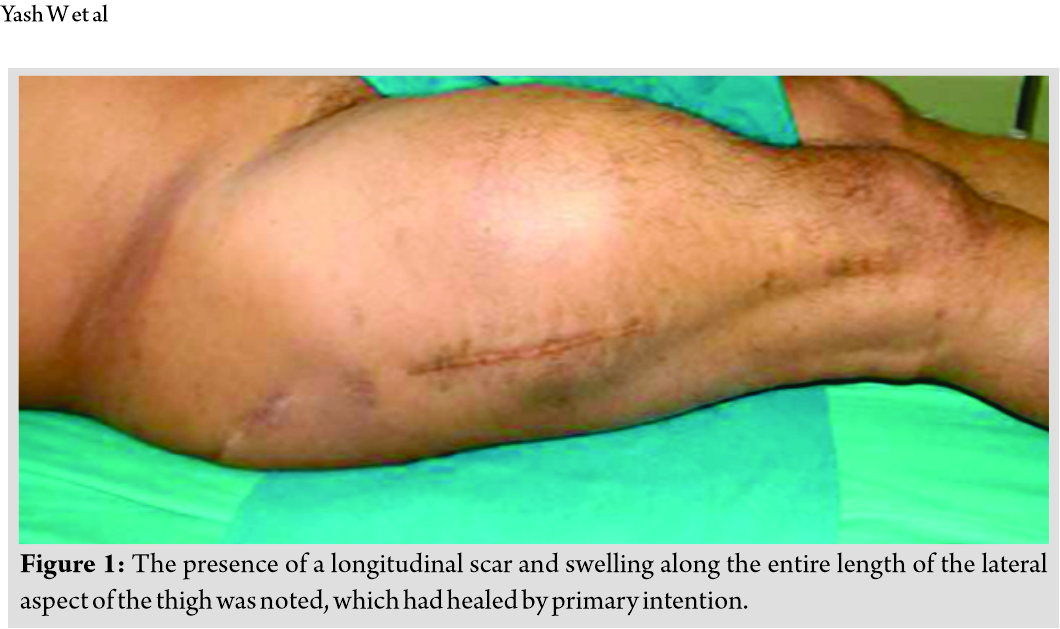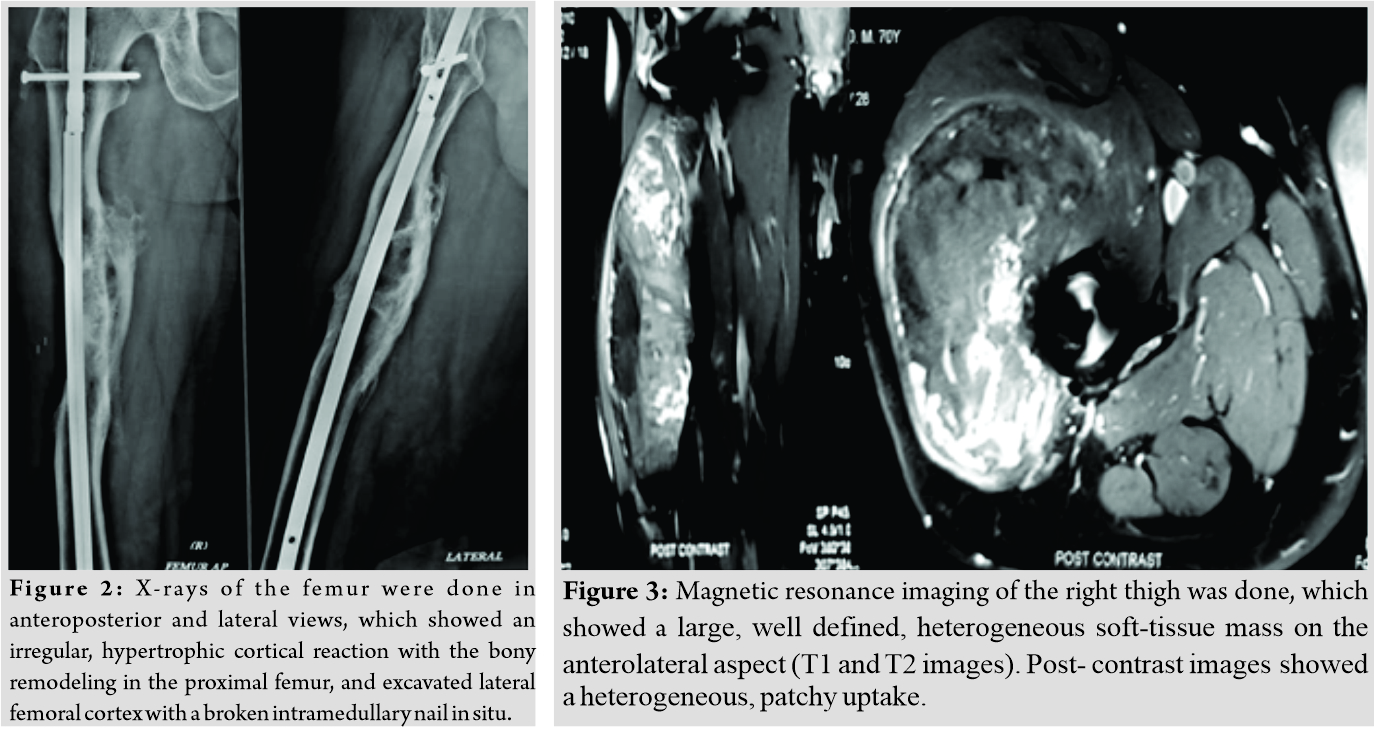[box type=”bio”] Learning Point of the Article: [/box]
Good operating theatre protocols should be followed and mop counts must be done multiple times to prevent this catastrophic complication.
Case Report | Volume 10 | Issue 5 | JOCR August 2020 | Page 12-15 | Wagh Yash, Reddy Rajeev, Gundavda Manit, Agarwal Manish. DOI: 10.13107/jocr.2020.v10.i05.1816
Authors: Wagh Yash[1], Reddy Rajeev[1], Gundavda Manit[1], Agarwal Manish[1]
[1]Department of Orthopaedic Oncology, P. D. Hinduja National Hospital and Medical Research Centre, Mumbai, Maharashtra, India.
Address of Correspondence:
Dr. Wagh Yash,
Department of Orthopaedic Oncology, P. D. Hinduja National Hospital and Medical Research Centre, Mumbai Maharashtra, India.
E-mail: yashwagh281@gmail.com
Abstract
Introduction: Gossypiboma is an iatrogenic lesion, caused by a retained surgical sponge in the operating field. It is an extremely rare event following musculoskeletal procedures and has devastating medicolegal consequences. It is hardly ever reported, and hence, the incidence is difficult to determine.
Case Report: We present a case report of a 70-year-old gentleman who presented with a painless swelling in the right thigh for 7 months. He had undergone open femoral nailing 10 years ago. Imaging studies suggested a soft-tissue sarcoma, but the biopsy was not conclusive. Intraoperatively, the mass was excised and found to have a thick fibrous wall with a gauze piece inside. Polarizing microscopy confirmed the diagnosis of gossypiboma.
Conclusion: Gossypiboma is an infrequent but devastating consequence of a human error. It is often difficult to diagnose and is confused with a soft-tissue sarcoma. Prevention of such untoward incidents by strict adherence to protocols is far better than cure.
Keywords: Mop, pseudotumor, chronic granulation, inconclusive histopathology.
Introduction
Gossypiboma is one of the rarest conditions reported in the orthopedic literature due to its grave medicolegal implications. It is a mass or a tumor arising from a mop or a sponge left inadvertently at the surgical site. Gossypiboma arises from a Latin term “gossypium” meaning cotton and “boma,” meaning concealment in Latin [1]. They are mostly reported in thoracic, abdomen, and pelvic surgeries and rarely seen or encountered in orthopedic surgery [2, 3]. The exact incidence is difficult to determine due to gross under-reporting and the catastrophic nature of this preventable condition. Good surgical protocols and check listing prior and after surgery are important to prevent a surgical sponge being retained in the body.
Case Report
A 70-year-old gentleman presented with a painless swelling in the right thigh for 7 months, which was spontaneous. He had a history of femur shaft fracture, for which open femur nailing was done 10 years ago. Postoperatively, he had uneventful wound healing and fracture union. He has no recollection of any complications following the surgery and was able to walk full-weight-bearing without any aid. Clinically, he had a large diffuse swelling on the anterolateral aspect of the right thigh which was around 10 cm × 8 cm. The swelling was firm, non-tender, and non-pulsatile, with ill-defined margins. The presence of a longitudinal scar along the entire length of the lateral aspect of the thigh was noted, which had healed by primary intention (Fig. 1). The right hip and knee movements were normal. Routine hematological tests were done, including erythrocyte sedimentation rate and C-reactive protein. All the blood reports were normal.
X-rays of the femur were done in anteroposterior and lateral views (Fig. 2) which showed an irregular, hypertrophic cortical reaction with the bony remodeling in the proximal femur and an excavated lateral femoral cortex with a broken intramedullary nail in situ. Magnetic resonance imaging (MRI) of the right thigh was done, which showed a large, well defined, and heterogenous soft-tissue mass on the anterolateral aspect (T1 and T2 images). Post-contrast images showed a heterogeneous and patchy uptake (Fig. 3). These findings were consistent with a soft-tissue tumor. We, however, did not perform a computed tomography (CT) scan for this patient.
After the MRI, we decided to do a closed needle biopsy along the previous surgical scar under local anesthesia in the operating theatre. The biopsy report was inconclusive, demonstrating fibrinous blood material and granulation tissue suggestive of a chronic hematoma. As the patient was symptomatic, we decided to plan a surgical excision of the lesion. Under epidural anesthesia, in the supine position. The skin incision was taken along the previous scar on the lateral aspect of the thigh. Granulation tissue and fibrosed muscles overlying the mass were carefully separated. We noticed a mass adherent to the lateral aspect of the femur extending intramedullary up to the implant. Using a cautery, we separated the mass from the bone extending up to the intramedullary nail. The excised specimen measured 24 cm in length and 15 cm in breadth. An intraoperative frozen section analysis was done that revealed a chronic inflammatory reaction and no evidence of sarcoma. The defect after excision of the mass was filled with frozen allograft. The excised specimen was solid with a fibrotic wall; on gross examination, after dissecting the specimen, a mop was found (Fig. 4a and b). The sample was sent for histological study which revealed fibrous strands, clots, hemolyzed pigments of red blood cells inflammatory cells, and multiple fiber strands. The foreign material was studied under polarized light (Fig. 5) and confirmed the diagnosis of gossypiboma by demonstrating cotton fibers. The specimen was reported as an accumulation of blood products and their degraded components and not a tumor. The patient had an uneventful surgical procedure and was mobilized and rehabilitation was started on day 1 postoperatively.
Discussion
Gossypiboma is also known as textiloma, muslinoma, gauzoma, and cottonoid [4, 5]. It is an iatrogenic condition, which develops due to reaction to a retained surgical sponge, sometimes many years after the initial surgery. They are more commonly seen in abdominal surgeries, where large potential spaces for mops to be left behind are present. However, they are rarely seen or reported in orthopedic surgeries of extremities, where these spaces are potentially small or absent [6]. To prevent this iatrogenic complication, it is important to maintain a strict mop count. Packages containing a fixed number of sponges, usually in multiples of ten, should be prepared. This makes it easier to record the number of mops before and after surgery. Our institute uses radiopaque markers on the mops and sponges used during surgery, making it easier to identify under imaging in case the post- and pre-operative counts do not match. A retained foreign material in the body usually exhibits two types of immune responses, the first where an acute reaction is seen with the local and systemic rise in temperature abscess a discharging sinus or fistula formation [7, 8]. The second is a rather slow or delayed response, as seen in our case study, where the immune system responds by the formation of a fibrous tissue around the foreign body. This slow and delayed response is usually aseptic and may, at times, take days, months, and sometimes even years to manifest. The lesion may appear to be a sarcoma on imaging, but the histopathological study is often misleading and confusing without giving a clear picture of the disease. CT is very useful in a suspicious lesion arising from a surgical site [9]. Entrapped gas bubbles are characteristic findings along with a spongiform appearance of the lesion. MRI has a limited role mainly due to the changing, very diverse, and often unreliable features [8, 1]. The MRI findings in our case study, however, showed wavy low-intensity stripes on the T2 weight images [3, 10].
Conclusion
Gossypiboma can have very serious complications for the patient and grave medicolegal consequences for the surgeon. Such cases receive widespread media coverage and may even lead to heavy lawsuits against the institution. Hence, strict protocols regarding sponge counts must be followed. A palpable tumor arising from a previously operated surgical with inconclusive imaging and histopathological findings must raise a strong suspicion of a gossypiboma. However, the possibility of a soft-tissue sarcoma must also not be completely ruled out.
Clinical Message
One must be aware of this rare presentation, especially when soft tissue or bony lesion arises from a previously operated site.
References
1. Manzella A, Filho PB, Albuquerque E, Farias F, Kaercher J. Imaging of gossypibomas: Pictorial review. AJR Am J Roentgenol 2009;193:S94-101.
2. Malot R, Meena DS. Gossypiboma of the thigh mimicking soft tissue sarcoma: Case report and review of literature. J Orthop Case Rep 2012;2:21-4.
3. Suwatanapongched T, Boonkasem S, Sathianpitayakul E, Leelachaikul P. Intrathoracic gossypiboma: Radiographic and CT findings. Br J Radiol 2005;78:851-3.
4. Ribalta T, McCutcheon IE, Neto AG, Gupta D, Kumar AJ, Biddle DA, et al. Textiloma (Gossypiboma) mimicking recurrent intracranial tumor. Arch Pathol Lab Med 2004;128:749-58.
5. Rajput A, Loud PA, Gibbs JF, Kraybill WG. Diagnostic challenges in patients with tumors: Case 1. Gossypiboma (foreign body) manifesting 30 years after laparotomy. J Clin Oncol 2003;21:3700-1.
6. Lo CP, Hsu CC, Chang TH. Gossypiboma of the leg: MR imaging characteristics. A case report. Korean J Radiol 2003;4:191-3.
7. Puri A, Anchan C, Jambhekar NA, Agarwal MG, Badwe RA. Recurrent gossypiboma in the thigh. Skeletal Radiol 2007;36:95-100.
8. De Marco JK, McDermott MW, Dillon WP, Bollen A, Edwards MS. MR appearance of postoperative foreign body granuloma: Case report with pathologic confirmation. AJNR Am J Neuroradiol 2007;12:190-2.
9. Lu YY, Cheung YC, Ko SF, Ng SH. Calcified reticulate rind sign: A characteristic feature of gossypiboma on computed tomography. World J Gastroenterol 2005;11:4927-9.
10. Prasad S, Krishnan A, Limdi J, Patankar T. Imaging features of gossypiboma: Report of two cases. J Postgrad Med 1999;45:18-9.
 |
 |
 |
 |
| Dr. Wagh Yash | Dr. Reddy Rajeev | Dr. Gundavda Manit | Dr. Agarwal Manish |
| How to Cite This Article: Yash W, Rajeev R, Manit G, Manish A. Gossypiboma: what happens when a mop is left in a thigh for ten years. Journal of Orthopaedic Case Reports 2020 August;10(5): 12-15. |
[Full Text HTML] [Full Text PDF] [XML]
[rate_this_page]
Dear Reader, We are very excited about New Features in JOCR. Please do let us know what you think by Clicking on the Sliding “Feedback Form” button on the <<< left of the page or sending a mail to us at editor.jocr@gmail.com






